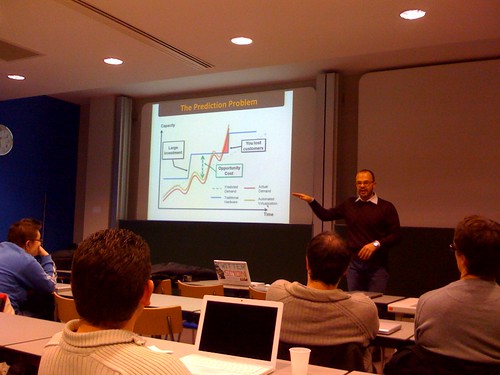
Here are the notes I mananged to make at CloudCamb, which was organised jolly well by Matt Wood (MZA on twitter).
Simone Brunozzi, Technical Evangelist, Amazon Web Services (simon on twitter)
Cloud computing helps answer the ‘prediction problem’ – knowing what your tech needs will be in the future
Need to expand to take advantage of an opportunity
What about periodical demand?
Results in extra cost and delays
lack of power and flexibility in infrastructure
Cloud computing allows a business to: focus on your skills, limit cap ex, scale quickly, reliable, innovate and save money
Principles of AWS: cloud computing, easy to use, secure, flexible, on demand, pay per use, self service, platform agnostic
Services: include S3 – storage, EC2 – virtual server, Cloudfront – content delivery, Database – SimpleDB
By end 2007 AWS were using more bandwidth than all Amazon retail sites put together. S3 objects (basically, files hosted) 800m in q3 2003, 29bn q3 2008
Cloud computing suits cloud computing. No upfront investment, cost effective, follow your success, shorter time to market
AMAZON S3 – Smugmug.com saved $500k pa using S3 (ie just by moving storage of files). Scalable online storage, cheap & reliable, simple APIs (REST, SOAP)
AMAZON EC2 – Vitual servers on demand, from $0.10 per hour, Linux, Windows, OpenSolaris all available. Elastic IP , Elastic Block store, availability zones, SLA 99.95% Licences for software can be paid for by the hour. Animoto Feb 08 80 ‘instances’ of EC2. Then launched facebook app went up to over 3500 by April. Would have been impossible to scale like that traditionally.
AMAZON CLOUDFRONT – Improve content delivery through caching. Easy setup, no committment, 8 locations in US, 4 in europe, 2 in Asia. Elastic and reliable. Tiered pricing.
AWS offers: fault tolerance, scalability, rapid innovation possible, no barriers of adoption, better pricing model, no upfront investment, faster time to market, choice, partners
Who uses? NY Times, Nasdaq, Washington Post, Linden Labs, amongst others
Future: operational excellent, security, certification for developers, international expansion, management console, load balance, auto-scaling, monitoring
EC2 now available in europe – though no Windows stuff
Amazon yet to not be able to provide service to a customer
Toby White – Inkling Software (tow21 on twitter)
Toby is talking about ‘Running a startup in the cloud’
All of Inkling’s servers run on EC2. But cost so far has been more than traditional servers, but that is not what matters. S3 is cheap, EC2 less so.
Ease of use – Inkling have few staff, have better things to do than server admin
Amazon makes process very easy, setting up new instances etc. Scriptable, repeatable and testable. Version controlling of AMIs. Forces you to consider these issues, which is a good thing.
Karim Chine – Computational e-Science in the Cloud: towards a federative and collaborative platform
Karim started by showing just how easy it is to use Amazon EC2. ElasticFox is an FF extension that helps manage the service.
There is a lot of science in this particular talk. I’m not sure I can keep up. It’s something about reproduceable computational results. I think. Just read this, if you want to know more.
Seriously, though, some of the stuff I understood about this show that the ability for people involved in scientific projects to collaborate over the internet in this way is superb, and the technology is clearly pretty innovative, not to mention hugely complicated. Given that I am attending a meeting in a building called the Centre for Mathematical Sciences, I would imagine that a lot of other people here would know a lot more about this than me.


